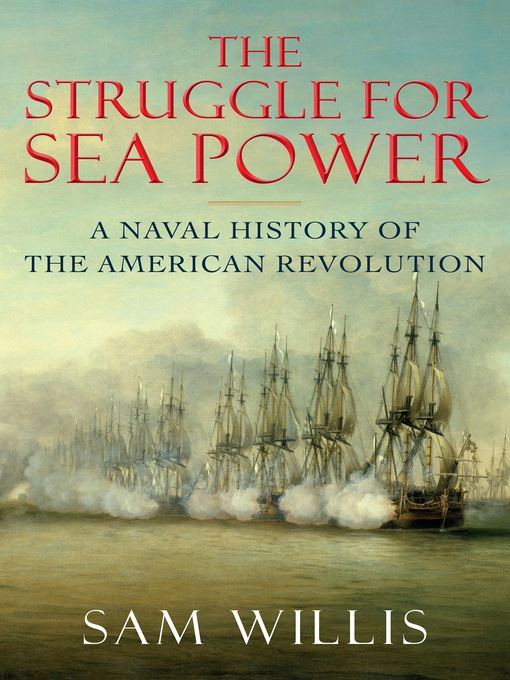
The Struggle for Sea Power
A Naval History of the American Revolution
کتاب های مرتبط
- اطلاعات
- نقد و بررسی
- دیدگاه کاربران
نقد و بررسی

November 16, 2015
In the U.S., the American Revolution is generally seen as a land war, but in this thorough and satisfying account, British maritime historian Willis (In the Hour of Victory) convincingly argues that the colonies’ rebellion sparked the “greatest war of the age of sail.” Not confined to North America, the war was waged globally by “no fewer than 22 separate navies” across oceans, freshwater lakes, and rivers, as well as on land, where sailors played crucial roles in combat and logistics. None of this was easy: communications were slow, naval strategy as an organized concept barely existed, and navies were expensive to operate and difficult to maintain. What began as a naval war for control of North America’s littoral and inland waters churned into a contest of battle fleets in 1778, when France entered the war. Spain and the Netherlands joined shortly after. Initially ineffective, the allied navies learned from mistakes. By 1781, the British “had lost control of the sea,” and, Willis states, “the huge, combined, unopposed French fleet set off to change the war.” Franco-Spanish cooperation altered the Caribbean balance, and a British army lacking naval support surrendered at Yorktown. “The war taught the British significant lessons,” Willis writes, and American readers will likewise learn from this naval perspective on the revolution. Maps & illus.

Starred review from November 15, 2015
A history of how the American revolt of 1775 evolved into a worldwide conflict. "Everyone knows that the first shot of this war was fired between soldiers on Lexington Common in 1775," writes highly acclaimed British naval historian Willis (In the Hour of Victory: The Royal Navy at War in the Age of Nelson, 2014, etc.), "but...the last was fired between warships at the battle of Cuddalore in the Bay of Bengal on 20 June 1783." The author takes nearly 500 pages to describe all this, but that includes many little-known distant campaigns, and readers can expect a thoroughly satisfying experience. Willis emphasizes that the Continental Congress' October 1775 resolution to create a navy marked the point of no return. Raising a militia was an ancient colonial right, so George Washington's army was technically legal. Raising a navy, however, was unprecedented. The resulting ragtag fleet never challenged the British Royal Navy, but showing the flag in foreign ports proclaimed that the rebellion was a going concern--and needed help. These ships--and those of 12 naval colonies--moved troops and equipment and harassed the enemy, but privateers inflicted the greatest pain, capturing thousands of merchant vessels during the years of the conflict. It was France and its allies that turned the tide, and Willis delivers an expert account of how they made independence a reality, but at considerable sacrifice. Spectacularly incompetent in America, Britain performed well almost everywhere else. Peace left Britain minus the American Colonies but with impressive gains in India, the Mediterranean, and the Caribbean. France, on the other hand, was bankrupt. A page-turner that delivers an eye-opening history of the American Revolution from a different perspective, as well as surprising details of what Willis maintains was the greatest war of the age of sail.
COPYRIGHT(2015) Kirkus Reviews, ALL RIGHTS RESERVED.

December 1, 2015
Naval historian Willis (In the Hour of Victory) delivers a comprehensive maritime history of the American Revolution, the first such treatment of this topic in over 20 years. According to Willis, "command of the water" was essential to virtually all aspects of the American war for independence. This conflict pitted America, France, Spain, and Holland against Britain and led to land and sea battles all over the world. Willis highlights the interconnectedness of the maritime with other spheres, observing that a naval clash in one place impacted the balance of power an ocean away; the mere appearance of a fleet could panic entire armies into retreat; and the Pennsylvania State Navy christened a warship the Hyder Ali, after a warlord resisting the British in India. The author devotes time to freshwater fleets, particularly the unheralded Anglo-American shipbuilding race as well as clashes on Lake Champlain along the Canada-U.S. border. VERDICT A mostly conventional military history, this narrative delivers a fresh look at the American Revolution's naval side. Aimed at the casual reader but comprehensive enough to attract specialists.--Michael Rodriguez, Hodges Univ. Lib., Naples, FL
Copyright 2015 Library Journal, LLC Used with permission.

























دیدگاه کاربران